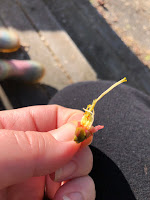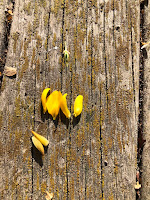Maramataka
Our moon is in Okoro, another good day for planting food; fun fact: I still haven't planted the potato...
Plant Reproduction
Essentially a flower is a massive reproductive organ and I can't look at a bouquet of flowers without being reminded of this...
Most flowers are brightly coloured and attractive to pollinators (the birds, the bees, bugs, bats - little critters), give off a scent that is irresistible to the critters, spread their pollen and pay the visitor with sweet treats.
The flowers have ovaries and eggs, and make embryos when met with plant sperm (pollen grains).
Fun fact: I have discovered I am highly allergic to Camelia sperm (pollen).
Our first task of the day was to find a flower to dissect, we initially could only find tiny specimens which made identifying the organs tricky. Then my mother picked up a beautiful pink camelia in her travels (the culprit of today's hayfever).
 |
Hunt for putiputi
|
 |
Our tiny finds
|
 |
| A gorse flower showing the outside Sepals and inside Petals |
 |
The Anthers, Stigma, Style and Ovary
|
 |
Teeny tiny Ovules inside the Ovary
|
 |
W investigating a gorse flower
|
 |
W investigating a daisy
|
 |
A Camelia showing the 'highway lights' for pollinators - directing them to the pollen
|
 |
Sepals
|
 |
Petals
|
 |
Anthers and Pollen
|
 |
Can you see the Stigma?
|
 |
Stigma leading to the Style and down to the Ovary
|
 |
Iti Ovules within the Ovary
|
The stigma picks up the pollen and creates a pollen tube leading down to the ovules/eggs within the ovary. This fertilisation only occurs after pollination (thank you bees). The ovary walls then swell and form the fruit that will then create a new generation of kākano to carry on the line of the plant.
I knew the idea of flowers as reproductive organs, with the pollen and stamen playing an important part in seed reproduction, I didn't realise how similar these organs are to ourselves, right down to the visuals, functions and names. We are all connected as living things and it makes complete sense why we use "birds and bees" as code for the big sex talk.
Our next task for this module was to gather kākano (seeds) and fruits and identify how the kākano would be dispersed.
Most seed dispersal takes place via Wind, Water, Self dispersal and animals (poop).
I also found out that fruit isn't limited to the juicy fruit we eat everyday but also refers to the seed pod, the paper like casing found around kākano such as the Kōwhai and Harakeke.
W was very keen on this activity, especially for a dandelion hunt.
With airborne dispersal you might recognise them as "helicopters" like the maple seeds but also the "parachutes" associated with dandelion fuzz.
We also found explosive seeds or as W refers to them as poppers which explode by touch and spread their seeds with bounce.
We weren't able to locate natural "velcro" seeds i.e. the biddy bids that attach to you while walking through long grasses.
Fruit seeds that are dispersed via animals weren't found either, however when we lived up north we would often find cherry pips on our deck from birds spitting them out.
We need our bees, our birds, our bugs; our little critters to ensure or plant life continues to grow and support us with food and shelter. If we don't have these small aspects of our life we really have nothing.
Pay attention to the finer details and look at the bigger picture.

























Comments
Post a Comment